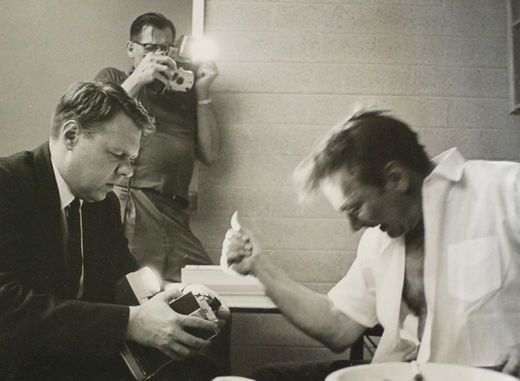
© The Baltimore Sun
The black-and-white Polaroid photo shows a building tilting precipitously to the right. Above what appears to be a picture window, a curving line of type clearly spells out "The Old Gold Store."
But when Ted Serios snapped that shot on May 13, 1965, he was sitting inside a hotel room, and the camera was pointed directly at his face.
More than 46 years later, there's no consensus as to whether what Serios described as a "thoughtograph" is an example of a genuine paranormal event, or if it ranks among history's most clever cons.
The alcoholic bellhop from Chicago, a former car thief and compulsive liar, claimed to be able to place images from his mind onto Polaroid film. In the mid-1960s, he participated in experiments conducted by Dr. Jule Eisenbud, a psychiatrist from the University of Denver. Over time, Serios generated about 1,000 images, 40 percent of which Eisenbud deemed to be paranormal.
"The images are spooky and mysterious," says Emily Hauver, who curated an exhibit currently running at the University of Maryland, Baltimore County. "To this day, Ted Serios' psychic abilities are hotly debated.
They have never been disproven, but they also have never been explained."Not surprisingly, Serios was a pop-culture sensation in the mid-1960s. His story appeared in Life magazine, and would-be debunkers challenged him before a live audience on
The Today Show. In 1999, Chris Carter, who created
The X-Files, optioned Serios' story for a movie.
Between 2002 and 2010, the Baltimore County university acquired the Jule Eisenbud Collection, consisting of 400 of the puzzling photographs. A few have previously been displayed in the Metropolitan Museum of Art in New York and Paris' La Maison Europeene de la Photographie.
But this is the first time a large-scale exhibit has been mounted of Serios' work, and it provides new fodder for believers and skeptics. The thoughtographs are grouped chronologically and by test session.
"If you're interested in the paranormal, you can come and look at this exhibit," Hauver says. "There's evidence for both points of view. You can decide for yourself whether the thoughtographs are real."
When Eisenbud first met Serios in April 1964, he expected to expose him as a fraud.
But when his admittedly troublesome test subject continued to produce the thoughtographs despite a series of increasingly stringent barriers, the scientist was gradually won over.

[Link]